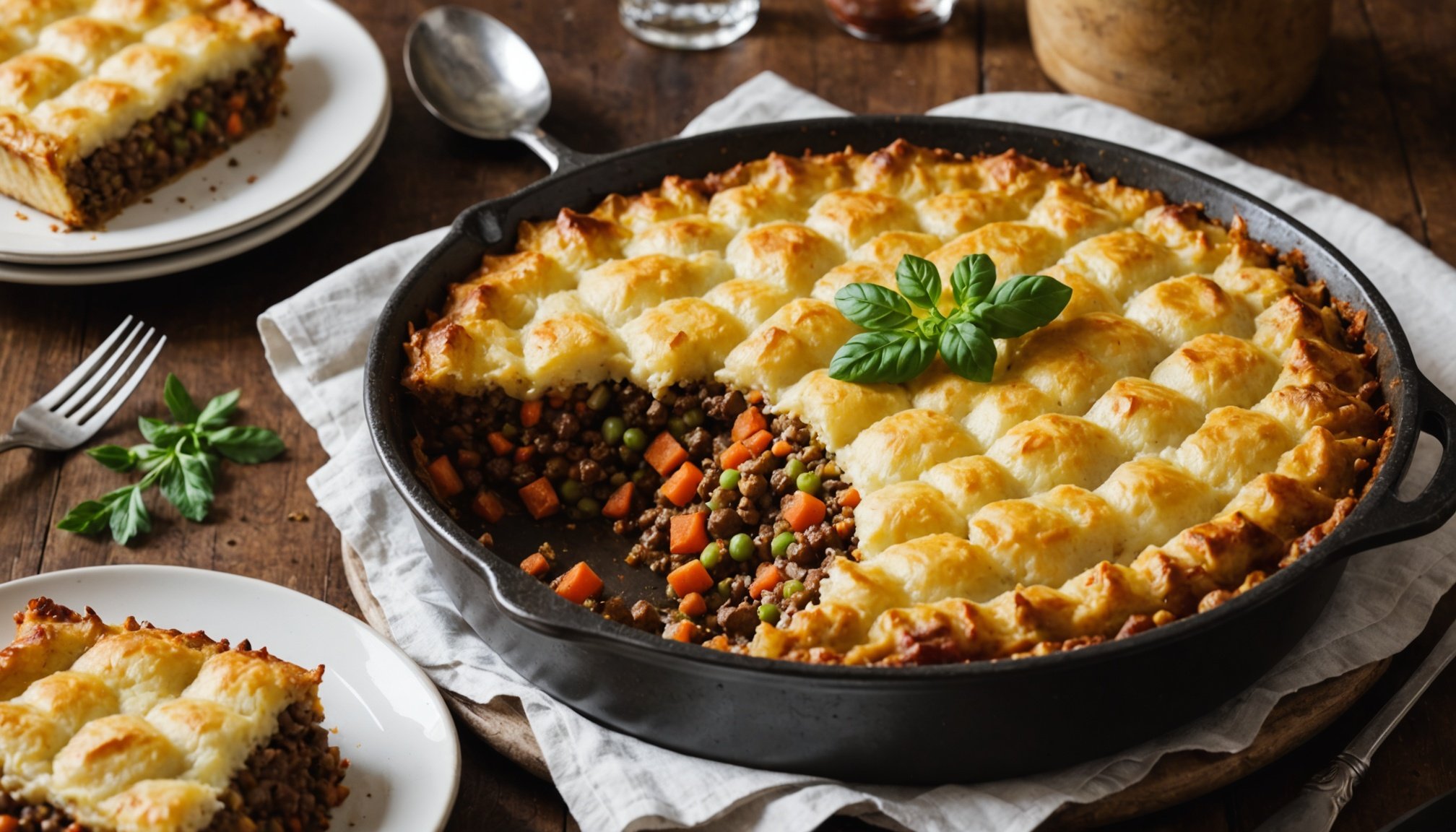Essential Ingredients for the Perfect Crust
Achieving the perfect cottage pie crust requires an understanding of key ingredients and their roles. The cornerstone of a good cottage pie is its crust, and crafting a delectable crust involves using foundational crust ingredients like flour and butter. Quality flour sets the base foundation, contributing to the crumbly and tender texture that is sought after in a pie crust. Choosing the right butter is equally crucial as it not only adds flavor but also ensures the desired flakiness of the crust.
In traditional pie-making, pie-making essentials extend beyond the basic ingredients. Incorporating optional ingredients can elevate the overall taste and appearance of the pie. Herbs, such as thyme or rosemary, introduce aromatic nuances that can complement the robust flavors of the filling. Similarly, adding a sprinkle of cheese to the crust mixture can provide a delightful savory touch, enhancing the buttery richness.
In parallel : Experience a Decadent Dark Chocolate Soufflé with a Surprising Spicy Twist!
While sticking to classic techniques is often the safest route, experimenting with subtle variations allows for a personalised touch. Thus, balancing the traditional with personal flourishes can lead to a sensational crust that stands out, offering both texture and flavor that demand a second helping.
Step-by-Step Guide to Preparing the Crust
Perfecting the cottage pie crust starts with precise measurements, a cornerstone of successful baking. Accurate ingredient preparation, including weighing flour and butter, ensures consistency. Use a digital scale for best results, minimising errors.
Also to discover : Experience a Decadent Dark Chocolate Soufflé with a Surprising Spicy Twist!
Measuring Ingredients Accurately
Precision is crucial. Flour should be spooned into the measuring cup, then levelled off, preventing excess and ensuring the right texture. Butter, often a key player in achieving flakiness, should be measured in grams for accuracy. This practice leads to a more consistent and reliable crust texture, crucial for that desired crumbly finish.
Mixing Techniques for Ideal Texture
Mixing methods significantly influence whether the crust turns out flaky or tender. For a flaky texture, butter should be cold and cut into the flour until pea-sized. Overmixing is a common mistake; it activates gluten, leading to toughness. Gently mix until just combined to maintain a tender outcome.
Chilling the Dough for Optimal Results
Chilling is more than just cooling; it’s a crucial step in crust preparation. The rest period allows gluten to relax and butter to firm up, which prevents shrinking during baking. A well-chilled dough is easier to roll, maintaining shape, and contributes to a beautifully structured crust. After mixing, wrap the dough in plastic and refrigerate for at least 30 minutes.
Rolling and Shaping the Crust
Crafting a perfectly even and smooth pie crust requires skill and patience, especially when rolling out the dough. To prevent sticking, always start by lightly flouring your work surface and the rolling pin. This step not only aids in achieving a consistent thickness but also ensures the dough doesn’t cling to your tools, thus avoiding tears.
Transferring the crust to the pie dish without damage can be achieved with a simple but effective technique: roll the dough over the rolling pin and unroll it over the pie dish gently. This method offers better control and reduces the chance of mishaps.
Once the dough is in place, consider crimping the edges. This not only seals the crust but adds an aesthetic touch. Using techniques like pinching with your fingers or pressing with a fork can create decorative patterns that elevate the pie’s presentation.
For those seeking creative flair, experimenting with different edge styles, like lattice or braided edges, can enhance the pie’s visual appeal. These finishing touches are not mere decoration; they reflect the baker’s craftsmanship and attention to detail, ensuring a picturesque and delightful pie.
Pre-baking Techniques for a Flaky Crust
Achieving a flaky crust often necessitates pre-baking methods, especially for pastries with moist fillings. This critical step ensures your crust remains crisp and well-structured throughout the baking process.
Importance of Pre-baking
Pre-baking, or blind baking, is vital when fillings could render the crust soggy, ensuring a fully-baked texture post-cooking. It involves partially baking the crust before adding the filling, which helps maintain its integrity.
Methods of Blind Baking
To blind bake, use parchment paper to line the pastry. Then, add baking weights like beans or rice. This holds the crust flat, preventing air bubbles. For a golden finish, partially bake until slightly firm, remove weights, and bake a bit longer.
Adjustments for Different Fillings
Each pie filling demands specific crust pre-baking. Denser fillings extend baking times, requiring a longer initial crust bake to prevent undercooked bottoms. For wetter fillings, like custards, ensure the crust is dry and sturdy by baking it completely before filling.
Incorporating these techniques enhances both the texture and durability of the pie crust, ensuring it stands out both visually and taste-wise. Experimenting with these methods can refine your pie-baking artistry, elevating your culinary creations.
Common Mistakes to Avoid
Creating the perfect cottage pie crust involves awareness of potential pitfalls. Identifying frequent pie crust mistakes can drastically improve your baking outcomes.
A common error is overworking the dough. Excessive handling can activate gluten, making the crust tough rather than tender. Another frequent issue is inaccurate measurement of crust ingredients. Even a slight deviation can alter the pie-making essentials balance, affecting texture and flavor.
Shrinkage during baking often results from insufficient chilling time. To combat this, ensure the dough is well-rested before rolling. Failure to adequately chill the dough is a major culprit behind excessive shrinking and tough crusts.
To prevent baking errors like soggy bottoms, consider pre-baking techniques. If a crust becomes soggy, it could be due to insufficient blind baking. Enhancing crust texture involves correctly implementing pre-baking methods, which stabilize the crust against moist fillings.
For those seeking effective solutions, here are a few:
- Prioritize precise ingredient measurements for consistency.
- Pay attention to dough’s resting time to mitigate shrinkage.
- Adopt pre-baking techniques to improve durability against fillings.
With these tips, troubleshooting becomes more manageable, and crafting a standout crust is entirely within your grasp.
Variations and Creative Twists on the Classic Crust
Incorporating crust variations into your pie can transform a traditional pastry into an exciting culinary adventure. Whether you’re seeking new flavours or aiming for health-conscious adjustments, there are endless possibilities to explore.
Savory Additions
One delightful way to enhance your pie is through savory additions. Infusing the dough with cheeses—like cheddar or Parmesan—can add a rich depth to the flavour profile. Additionally, sprinkling herbs such as thyme or chives into the dough introduces aromatic undertones that complement both the crust and the filling.
Healthier Alternatives
For those opting for a more healthful choice, experimenting with alternative pie crusts is a promising option. Substituting traditional wheat flour with whole-grain or almond flour offers a nutritious twist without compromising texture. Moreover, using coconut oil or avocado in place of butter can achieve a similar tenderness, while accommodating dietary preferences.
Global Influences on Crust
Pie crusts also boast creative baking elements from around the world. Examining international variations, like using phyllo dough for a Greek-inspired spin, can inspire innovative creations. Each culture brings unique techniques and ingredients, proving that these influences can enrich your pie-baking repertoire, blending tradition with creativity.
Historical Context of Cottage Pie
Understanding the cottage pie history requires delving into the origins of this beloved dish. Emerging in the late 18th century, cottage pie was traditionally crafted as a means to utilize leftover meat. The term “cottage” reflects a humble origin, implying its ties to rural dwellings.
Rooted in traditional English dishes, cottage pie holds a notable place in British cuisine. Its evolution is linked to the domestication of potatoes in the UK, which became the staple topping for the pie. The dish was economical and hearty, providing sustenance to working-class families.
As culinary practices modernised, cottage pie recipes evolved, integrating international influences while retaining classic elements. Variations, such as incorporating different proteins like beef or lamb, emerged over time. Despite these adaptations, the essence of the dish, with its comforting layered components, remains unchanged.
Today, cottage pie is celebrated across the globe for its versatile nature and robust flavours, embodying simplicity and warmth. It stands as a testament to how traditional English cuisine continues to thrive and adapt, sustaining its culinary significance amidst new trends. The dish’s enduring popularity highlights its ability to connect the past with contemporary tastes.





